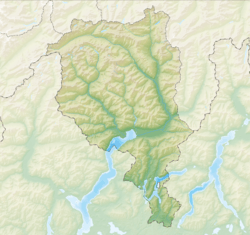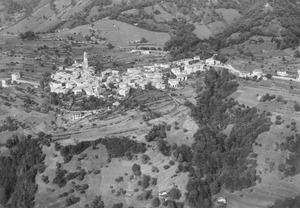Caneggio facts for kids
Quick facts for kids
Caneggio
|
||
|---|---|---|
|
||
| Country | Switzerland | |
| Canton | Ticino | |
| District | Mendrisio | |
| Area | ||
| • Total | 3.53 km2 (1.36 sq mi) | |
| Elevation | 555 m (1,821 ft) | |
| Population | ||
| • Total | 337 | |
| • Density | 95.47/km2 (247.3/sq mi) | |
| Postal code |
6837
|
|
| Surrounded by | Bruzella, Cabbio, Castel San Pietro, Cernobbio (IT-CO), Moltrasio (IT-CO), Morbio Superiore | |
Caneggio was once a municipality (a type of local government area) in the Mendrisio district. This district is part of the canton of Ticino in Switzerland. On October 25, 2009, Caneggio joined with several other municipalities. These were Bruzella, Cabbio, Morbio Superiore, Muggio, and Sagno. Together, they formed the new municipality of Breggia.
Contents
A Look Back: Caneggio's History
Caneggio was first mentioned in official papers in 1209. Back then, it was called Canegio. Later, in 1335, it was known as Canezio.
Ancient Discoveries in Caneggio
Interesting finds from the Roman era have been made here. Graves from that time were discovered in an area called Campora.
The Village Church
The village used to be part of the Bruzella church area. They became separate in 1649. Caneggio then likely joined the Balerna church area around the same century. The church of S. Maria Assunta was first mentioned in 1566. It was rebuilt in 1715 and later renovated between 1971 and 1975.
How People Lived and Worked
Caneggio didn't have much land for farming. So, people mostly earned a living from alpine pastures (mountain grazing lands) and forestry. Because of the limited land, many people from the village moved to other countries. In the second half of the 1900s, more jobs became available in the services sector. This helped the population become more stable. Today, most residents travel to other places for work.
Caneggio's Geography
As of 1997, Caneggio covered an area of about 3.53 square kilometers (1.36 square miles).
Land Use in Caneggio
- About 7.4% of the land was used for farming.
- A large part, about 98.0%, was covered by forests.
- Around 5.7% of the land had buildings or roads.
- A small portion, about 1.1%, was rivers or lakes.
Most of the forested land, 95.5%, was dense forest. The remaining 2.5% had orchards or small groups of trees. For farming, 4.2% was used for growing crops. Another 3.1% was used for mountain pastures. All the water in the area is flowing water, like streams.
Location and Nearby Areas
The village is located in the Mendrisio district. It sits on the left side of the Valle di Muggio (Muggio Valley). Until 2004, the settlement of Campora was part of Caneggio. Campora is on the other side of the valley. However, it is now part of Castel San Pietro.
Caneggio's Coat of Arms
The blazon (official description) of Caneggio's coat of arms is simple. It shows a silver (white) dog's head on a blue background.
Population and People
As of December 2004, Caneggio had a population of 337 people.
Languages Spoken
In 2000, most people in Caneggio spoke Italian (317 people). A smaller number spoke German (18 people) or French (4 people). Four other people spoke different languages.
Population Changes
In 2008, there were 3 babies born to Swiss citizens. The total Swiss population in Caneggio increased by 11 people that year. The number of non-Swiss residents decreased by 3. Overall, the population grew by 2.5% in 2008.
Homes in the Village
In 2000, there were 156 buildings where people lived. Most of these, 131 (84.0%), were single-family homes. There were also 23 multi-family buildings (14.7%). Out of 190 apartments, 147 (77.4%) were lived in all year. Some were used only during certain seasons (20.5%), and a few were empty (2.1%).
Historical Population Chart
The chart below shows how Caneggio's population has changed over many years:

Caneggio's Economy
In 2008, there were 33 full-time jobs in Caneggio.
Types of Jobs
- Primary sector: 3 jobs were in agriculture (farming).
- Secondary sector: 18 jobs were in construction (building things).
- Tertiary sector: 12 jobs were in services. These included:
- 4 jobs (33.3%) in selling or repairing cars.
- 1 job (8.3%) in moving and storing goods.
- 3 jobs (25.0%) in hotels or restaurants.
- 2 jobs (16.7%) in education.
Commuting for Work
In 2000, 16 workers traveled into Caneggio for their jobs. However, 119 workers from Caneggio traveled out to work elsewhere. This means many more people leave Caneggio for work than come in. About 25% of the people who came to work in Caneggio were from outside Switzerland.
Religion in Caneggio
Based on the 2000 census, most people in Caneggio were Roman Catholic (300 people or 87.5%). A smaller group, 18 people (5.2%), belonged to the Swiss Reformed Church. Some people belonged to other churches, and a very small number did not answer the question.
Education
In 2000, 43 students from Caneggio went to schools outside the village.





